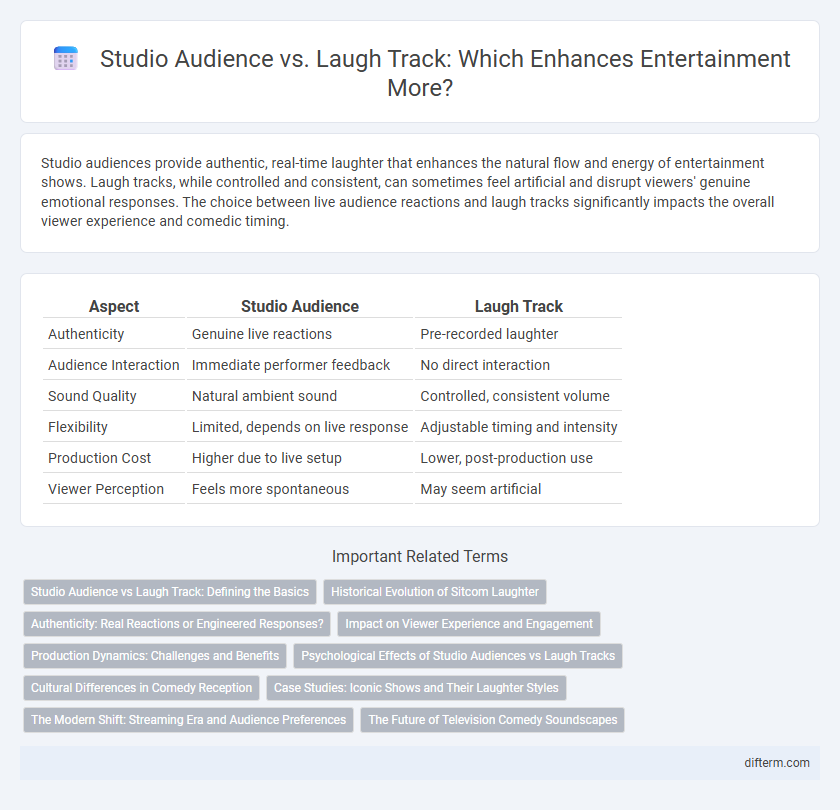Studio audiences provide authentic, real-time laughter that enhances the natural flow and energy of entertainment shows. Laugh tracks, while controlled and consistent, can sometimes feel artificial and disrupt viewers' genuine emotional responses. The choice between live audience reactions and laugh tracks significantly impacts the overall viewer experience and comedic timing.
Table of Comparison
| Aspect | Studio Audience | Laugh Track |
|---|---|---|
| Authenticity | Genuine live reactions | Pre-recorded laughter |
| Audience Interaction | Immediate performer feedback | No direct interaction |
| Sound Quality | Natural ambient sound | Controlled, consistent volume |
| Flexibility | Limited, depends on live response | Adjustable timing and intensity |
| Production Cost | Higher due to live setup | Lower, post-production use |
| Viewer Perception | Feels more spontaneous | May seem artificial |
Studio Audience vs Laugh Track: Defining the Basics
Studio audiences provide live, spontaneous reactions that enhance the authenticity of comedy shows, capturing genuine laughter and applause in real time. Laugh tracks are pre-recorded audio effects inserted to simulate audience reactions, often used to ensure consistent comedic pacing or to mask weak humor. Understanding the distinction helps creators decide between organic audience engagement or controlled, predictable sound effects to influence viewer perception.
Historical Evolution of Sitcom Laughter
Studio audiences shaped early sitcom laughter by providing genuine, real-time reactions, enhancing comedic timing and authenticity. The 1950s introduced laugh tracks as a cost-effective alternative, standardizing audience responses and ensuring consistent laughter regardless of viewer presence. Advances in sound technology and changing production methods gradually blurred the line between live and recorded audience feedback, reflecting evolving industry practices and viewer preferences.
Authenticity: Real Reactions or Engineered Responses?
Studio audiences capture authentic reactions, providing genuine laughter that enhances the viewing experience by reflecting true audience engagement. Laugh tracks, in contrast, are engineered responses designed to simulate or amplify humor, often leading to artificial or repetitive cues that may undermine authenticity. The debate hinges on whether viewers prefer spontaneous, real-time feedback or manufactured responses engineered to guide their emotional reactions.
Impact on Viewer Experience and Engagement
Studio audiences provide authentic, spontaneous reactions that enhance the viewer's sense of connection and engagement, making comedic moments feel more genuine. Laugh tracks can manipulate audience perception by signaling when to laugh, but may sometimes feel forced or artificial, reducing emotional impact. Real-time audience responses contribute significantly to the overall energy and viewer immersion in entertainment programs.
Production Dynamics: Challenges and Benefits
Studio audiences provide authentic real-time reactions that enhance comedic timing and energy, creating dynamic interactions between performers and viewers. Laugh tracks offer controlled consistency, allowing producers to tailor audience responses and maintain pacing across diverse scenes. Balancing live spontaneity with post-production precision presents challenges but ultimately enriches viewer engagement and show quality.
Psychological Effects of Studio Audiences vs Laugh Tracks
Studio audiences trigger genuine social connection and empathy through live laughter, enhancing viewers' emotional engagement and perceived humor authenticity. Laugh tracks, although effective in signaling humor, may create artificial social cues that can reduce emotional resonance and lead to cognitive dissonance in viewers. Psychological studies reveal that the presence of real-time audience feedback significantly boosts amusement and memory retention compared to prerecorded laugh tracks.
Cultural Differences in Comedy Reception
Studio audiences provide authentic laughter and real-time feedback that can enhance comedic timing, resonating more naturally with viewers in Western cultures where live audience reactions are valued. Laugh tracks, prevalent in many non-Western or remote productions, serve to cue viewers to comedic moments, aligning with cultural norms that favor guided humor perception. Variations in cultural preferences impact how humor is received; for instance, Japanese and Korean comedies often rely on scripted cues rather than spontaneous studio reactions, highlighting differing comedic traditions and audience expectations.
Case Studies: Iconic Shows and Their Laughter Styles
Iconic shows like "Friends" and "The Big Bang Theory" illustrate distinct laughter styles, with live studio audiences capturing authentic reactions in real-time, enhancing viewer engagement through genuine responses. In contrast, shows like "The Office" use laugh tracks to guide audience emotions subtly, crafting a tailored comedic rhythm that complements the mockumentary style. Case studies demonstrate that live laughter often boosts perceived humor, whereas laugh tracks maintain timing consistency and structural control over comedic beats.
The Modern Shift: Streaming Era and Audience Preferences
The modern shift in entertainment consumption, driven by the streaming era, has transformed the debate between studio audience laughter and laugh tracks. Streaming platforms prioritize authenticity and viewer engagement, leading many productions to favor natural audience reactions over artificial laugh tracks. This trend reflects a broader preference for immersive, relatable content that resonates with contemporary audiences seeking genuine entertainment experiences.
The Future of Television Comedy Soundscapes
Studio audiences provide authentic, real-time laughter that enhances the immersive experience of television comedy, capturing genuine emotional responses and spontaneity. Laugh tracks, while engineered for consistency, can feel artificial, potentially distancing viewers by signaling humor rather than organically generating it. Emerging technologies in audio production aim to blend the spontaneity of live audiences with the precision of laugh tracks, shaping the future soundscapes of television comedy for a more dynamic and engaging viewer experience.
Studio audience vs laugh track Infographic

 difterm.com
difterm.com